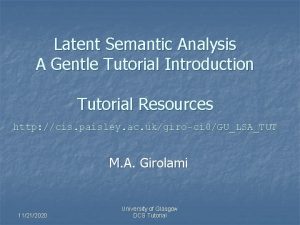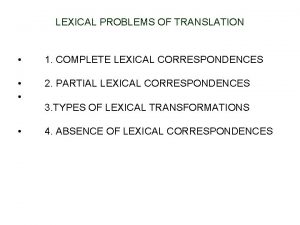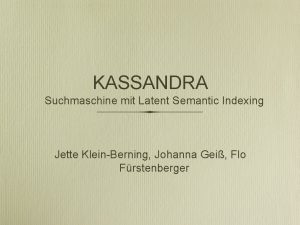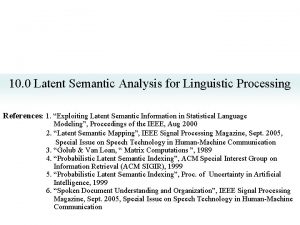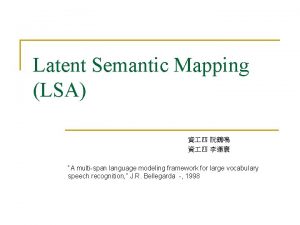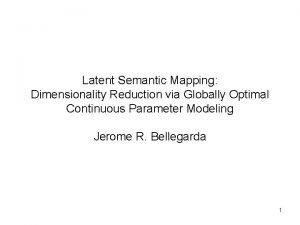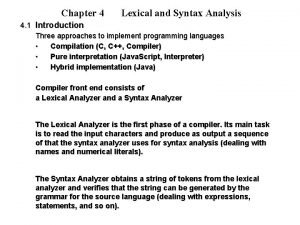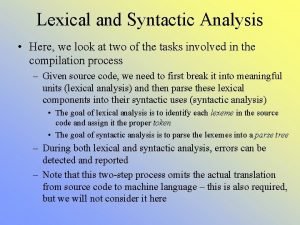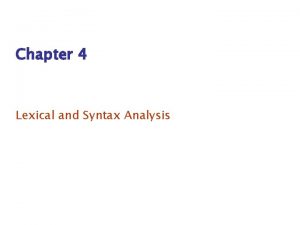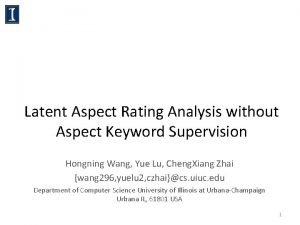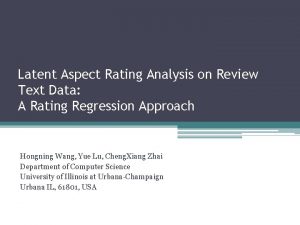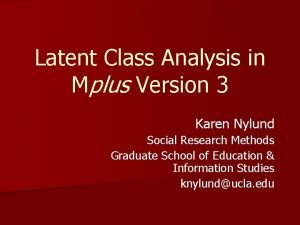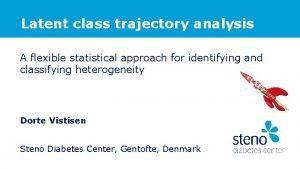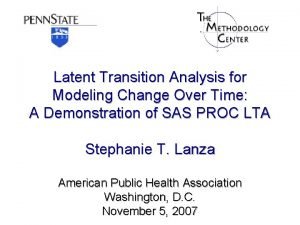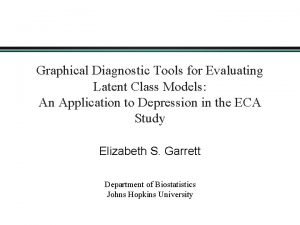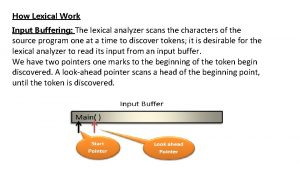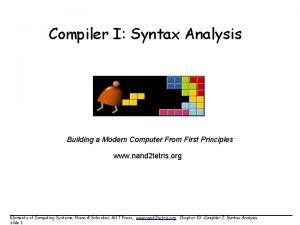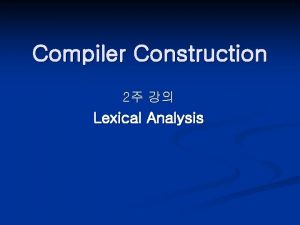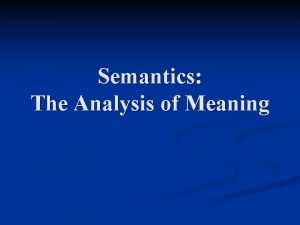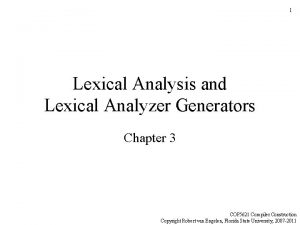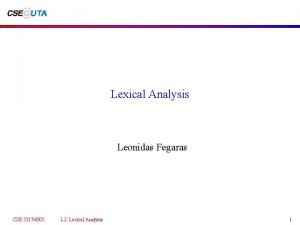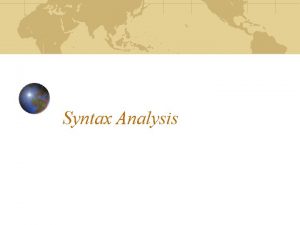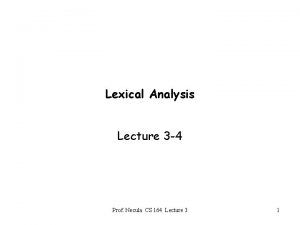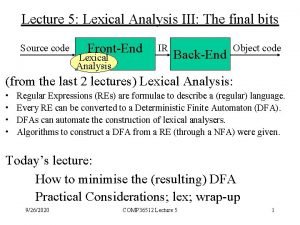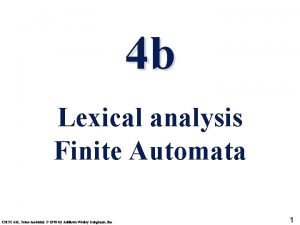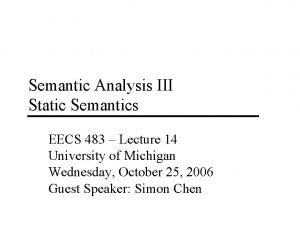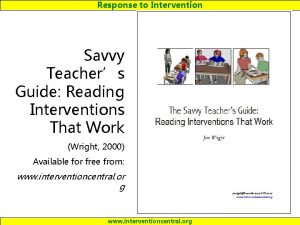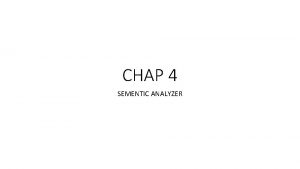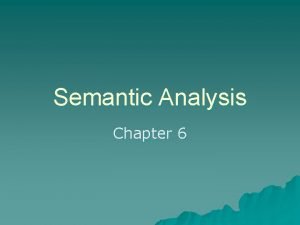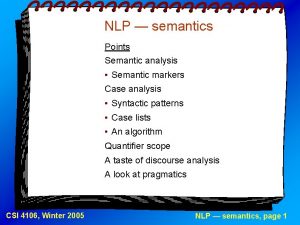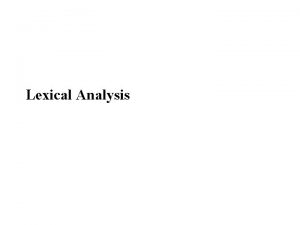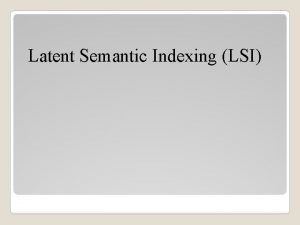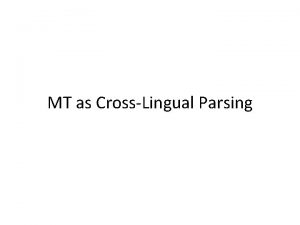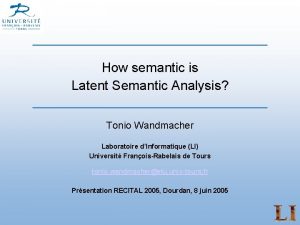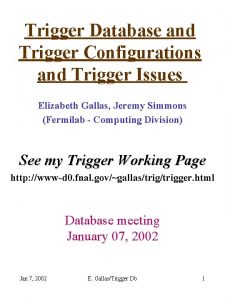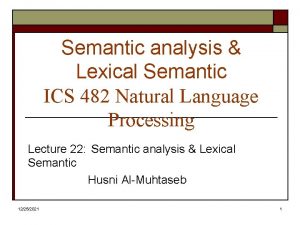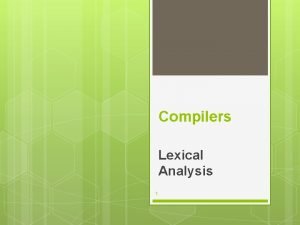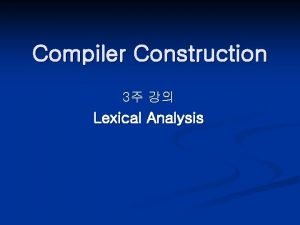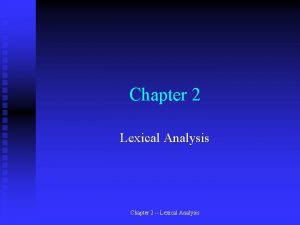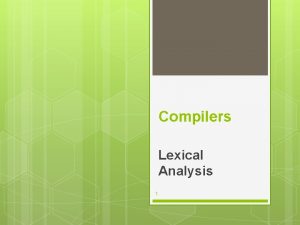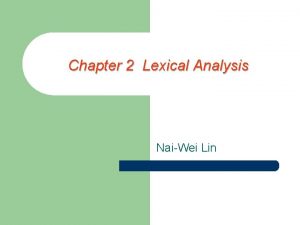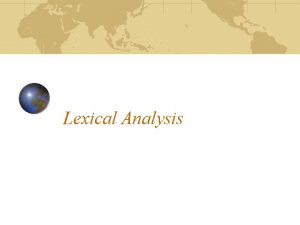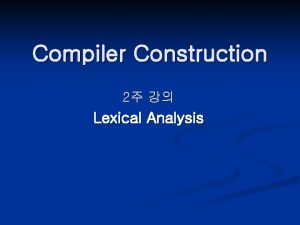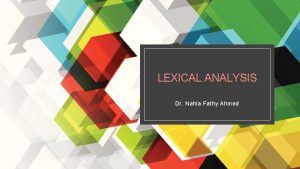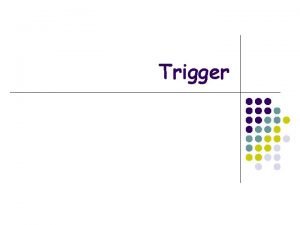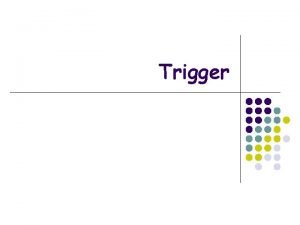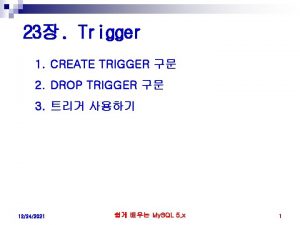Lexical Trigger and Latent Semantic Analysis for CrossLingual




































- Slides: 36

Lexical Trigger and Latent Semantic Analysis for Cross-Lingual Language Model Adaptation WOOSUNG KIM and SANJEEV KHUDANPUR 2005/01/12 邱炫盛

Outline • Introduction • Cross-Lingual Story-Specific Adaptation • Training and Test Corpora • Experimental Results • Conclusions

Introduction • Statistic language models are indispensable components of many human language technologies. e. g. ASR, IR, MT. • The best-known techniques for estimating LMs require large amounts of text in the domain and language of interest, making this a bottleneck resource. e. g. Arabic. • There have been attempts to overcome this data scarcity problem in the components of speech and language processing systems. E. g. acoustic modeling, linguistic analysis from resource-rich language to resourcedeficient language.

Introduction (cont. ) • For language modeling, if sufficiently good MT is available between resource-rich language, such as English and a resource-deficient language, say Chinese, then one may choose English documents, translate, and use resulting Chinese word statistics to adapt LMs. • Yet, the assumption of some MT capability presupposes linguistic resources may not be available for some languages. – Modest sentence-aligned parallel corpus • Two primary means of exploiting cross-lingual information for language modeling are investigated, neither of which requires any explicit MT capability – Cross-Lingual Lexical Triggers – Cross-Lingual Latent Semantic Analysis

Introduction (cont. ) • Cross-Lingual Lexical Triggers: several content-bearing English words will signal the existence of a number of content-bearing Chinese counterparts in the story. If a set of matched English-Chinese stories is provided for training, one can infer which Chinese words an English word would trigger by using statistic measure. • Cross-Lingual Latent Semantic Analysis: LSA of a collection of bilingual document-pairs provides a representation of words in both languages in a common low-dimensional Euclidean space. This provides another means for using English word-frequencies to improve the Chinese language model from English text. • It is shown through empirical evidence that while both techniques yield good statistics for adapting a Chinese Language model to a particular story, the goodness of the information varies from story to story.

Cross-Lingual Story-Specific Adaptation

Cross-Lingual Story-Specific Adaptation • • Our aim is to sharpen a language model in a resource-deficient language, by using data from a resource-rich language. Assume for the time being that a sufficiently good Chinese-English story alignment is given. Assume further that we have a stochastic translation lexicon-a probabilistic model PT(c|e) Cross-Lingual Unigram Distribution

Cross-Lingual Unigram Distribution Use cross-lingual unigram statistic to sharpen a statistic Chinese LM used for processing the test story di. C. Linear interpolation: Variation:

Obtaining the Matching English Documents di. E • • Assume that we have a stochastic reverse translation lexicon PT(e|c). Compute: • An English bag-of-words representation of the Mandarin story di. C as used in standard vector-based information retrieval. The document di. E with highest TF-IDF weighted consine-similarity is the selected: • • Called query-translation approach to CLIR

Obtaining Stochastic Translation Lexicons • Translation lexicons: PT(c|e) and PT(e|c) – Created out of multiple translations of a word – Stemming and other morphological analyses may be applied to increase the vocabulary coverage. – Alternately, they may be obtained from parallel corpus using MT techniques, such as GIZA++ tools. – Apply the translation models to entire articles, one word at a time, to get a bag of translated words. – However, obtaining translation probabilities using very long (documentsized) sentence-pair has its own issues. • For truly resource-deficient language, one may obtain a translation lexicon via optical character recognition from a printed bilingual dictionary.

Cross-Lingual Lexical Triggers • It seems plausible that most of information one gets from the crosslingual unigram LM is in the form of the altered statistics of topic-specific Chinese words conveyed by the statistics of content-bearing English words in the matching story. • The translation lexicon used for obtaining the information is an expensive resource. • If one were only interested in the conditional distribution of Chinese words given some English words, there is no reason to require translation as an intermediate step. • In monolingual setting, the mutual information between lexical-pairs cooccurring anywhere within a long “window” of each other has been used to capture statistical dependencies not covered by N-gram LMs.

Cross-Lingual Lexical Triggers (cont. ) • A pair of words (a, b) is considered a trigger-pair if, given a word-position in a sentence, the occurrence of a in any of the preceding word-positions significantly alter the probability that the following word in the sentence is b: a is said to trigger b. (The set of preceding word-positions is variably defined. e. g. sentence, paragraph, document. ) • In the cross-lingual setting, a pair of words (e, c) to be a trigger-pair. ( Given an English-Chinese pair of aligned documents) • Translation-pair will be natural candidates for translation-pair, however, it is not necessary for a trigger-pair to also be a translation pair. – E. g. Belgrade may trigger the Chinese translation of Serbia, Kosovo, China, embassy and bomb.

Cross-Lingual Lexical Triggers (cont. ) • Average mutual information, which measures how much knowing the value of one random variable reduces the uncertainty of about another, has been used to identify trigger-pairs. • Compute the average mutual information for every English-Chinese wordpair (e, c): • There are |E|x|C| possible English-Chinese word-pairs which may be prohibitively large to search for the pairs with the highest mutual information. So filter out infrequent words in each language, ex. <5, then measure I(e; c) for all possible pairs, sort them by I(e; c) and select top one million pairs.

Cross-Lingual Lexical Triggers (cont. )

Estimating Trigger LM Probabilities • • Estimate probability PTrig(c|e) and PTrig(e|c) in lieu of the translation probability PT(c|e) and PT(e|c). PTrig(c|e) is based on the unigram frequency of c among Chinese word tokens in that subset of aligned documents di. C which have e in di. E. • Alternative: • I(e; c)=0 whenever (e, c) is not a trigger-pair, and find it to be more effective.

Estimating Trigger LM Probabilities (cont. ) Interpolated model:

Cross-Lingual Latent Semantic Analysis • CL-LSA is a standard automatic technique to extract corpus-based relations between words or documents. • Assume that a document-aligned Chinese-English bilingual corpus is provided. First step is to represent the corpus as a word-document cooccurrence frequency matrix W in which each row represent a word I one of the two language, and each column a document-pair. • W is M×N matrix. M=|C∪E|, N is the number of document-pairs. • Each element wij of W contains the count of the ith word in the jth document -pair. • Next, each row of W is weighted by some function, which deemphasizes frequent (function) words in either language, such as the inverse of the number of documents in which the word appears.

CL-LSA (cont. ) • • Then SVD is performed on W, and some R <<min {M, N}. . • In the rank-R approximation, the jth column W*j of W or document-pair dj. E and dj. C, is a linear combination of the columns of U×S, the weight for the linear combination being provided by the jth column of VT • Similarly,

Cross-Language IR • CL-LSA provides a way to measure the similarity between a Chinese query and English document without using a translation lexicon PT(e|c). • Construct a word-document matrix using the English corpus. All rows corresponding the Chinese vocabulary item have zeros in this matrix. • Project dj. E into semantic space and obtain the R-dimensional representations • Similarly, project Chinese query di. C and calculate consine-similarity between query and documents.

LSA-Derived Translation Probabilities • • • Use CL-LSA framework to construct the translation model PT(c|e). In matrix W, each word is represented as a row no matter whether it is English or Chinese. Project words into R-dimensional space yields row of U, and measure the semantic similarity by consine-similarity. Word-word translation model Exploit a large English corpus to improve Chinese LMs, as well as the use of a document-aligned Chinese-English corpus to overcome the need for a translation lexicon.

Topic-dependent language models • • • The combination of the story-dependent unigram models with a storyindependent trigram model using linear interpolation seems to be a good choice as they are complementary. Construct monolingual topic-dependent LMs and contrast performance with CL-lexical triggers and CL-LSA. Use well-known k-means clustering algorithm. Use a bag-of-words centroid to represent each topic. Each topic-centroid ti has highest TF-IDF weighted consine-similarity. We believe that the topic-trigram model is a better model, making for informative, even if unfair comparison.

Training and Test Corpora • Parallel Corpus: Hong Kong News – Used for training of GIZA++, construction of trigger-pairs and crosslingual experiment. – Contains 18, 147 document-aligned documents. (actually a sentencealigned corpus) – Dates from July 1997 to April 2000. – Removes a few articles containing nonstandard Chinese characters. – 16, 010 for training, 750 for testing. – 4. 2 M-word Chinese training set, 177 K-word Chinese test set. – 4. 3 M-word English training set, 182 K-word English test set.

Training and Test Corpora (cont. ) • Monolingual Corpora: – XINHUA: 13 million words. Estimate baseline trigram LM – HUB-4 NE: estimate a trigram model from 96 K words in the transcription for training acoustic model. – NAB-TDT: contemporaneous English texts, 45000 articles containing about 30 million words.

Experimental Results • Cross-Lingual Mate Retrieval: CL-LSA vs. Vector-based IR • use well-tuned translation dictionary PT(e|c) (by GIZA++) in Vector-based IR. • Due to memory limitation, 693 was the maximum.

Experimental Results (cont. ) • Baseline ASR Performance of Cross-Lingual LMs P-value are based on the standard NIST MAPSSWE test. http: //www. sportsci. org/resource/stats/pvalues. html http: //www. ndhu. edu. tw/~power/ The improvement brought by CL-interpolated LM is not statistically significant on XINHUA. On HUB-4 NE, Chinese LM text is scare, the CL-interpolated LM delivers considerable benefits via the large English Corpus.

Experimental Results (cont. ) • • • Likelihood-Based Story-Specific Selection of Interpolation Weight and the Number of English Documents per Mandarin Story N-best documents: – experimented with values of 1, 10, 30, 50, 80, 100 and found that N=30 is best for LM performance, but only marginally better than N=1. All documents above a similarity threshold: – the argument against always taking a predetermined number of the best matching documents may be that it ignores the goodness of match. – Threshold=0. 12 gives the lowest perplexity, the reduction is insignificant. – the number of documents selected now varies story to story. • Some stories even the best matching document falls below the threshold. – This points to the need for a story-specific strategy for choosing the number of English documents.

Experimental Results (cont. ) • Likelihood-based selection of the number of English documents:

Experimental Results (cont. ) • The perplexity varies according to the number of English documents, and the best performance is achieved at different points for each story. • For each choice of the number of documents, also λ, is chosen to maximize the likelihood of the first pass output. • Choose 1000 -best-matching English documents and divide the dynamic range of their similarity score into 10 interval. • Choose top one-tenth, not necessarily the top 100 documents, compute PCL-unigram(c|di. E), determine λ that maximizes the likelihood of the first pass output of only the utterances in that story, and record this likelihood. • Repeat this in top two-tenth, three-tenth, and so on. • Obtain the likelihood as a function of similarity threshold. • Called Likelihood-based story-specific adaptation scheme

Experimental Results (cont. )

Experimental Results (cont. ) • Comparison of Cross-Lingual Triggers and CL-LSA with Stochastic Transition Dictionaries

Experimental Results (cont. ) • Comparison of Stochastic Translation with Manually Created Dictionaries MRD: machine-readable dictionary, 18 K English-to-Chinese entries and 24 K Chinese-to-English entries from LDC translation lexicon. Use MRD in place of a stochastic translation lexicon PT(e|c). http: //www. ldc. upenn. edu/Projects/Chinese/LDC_ch. htm MRD leads to a reduction in perplexity, no reduction in WER.

Conclusions • A statistically significant improvement in ASR WER and in perplexity. • Our methods are even more effective when LM training text is hard to come by. • We have proposed methods to build cross-lingual language model, which do not require MT. • By using mutual information statistics and latent semantic analysis form document-aligned corpus, we can extract a significant amount of information for language modeling. • Future work – Develop maximum entropy models to more effectively combine the multiple information source.

• Separability between intra- and inter-topic pairs is much better in the LSA space than in the original space.

, (drawing) , (rule)


• W=7 x 4 matrix (word-command matrix), R=2
 Latent semantic indexing tutorial
Latent semantic indexing tutorial Latent heat dimension
Latent heat dimension Lexical problems
Lexical problems Latent semantic indexing
Latent semantic indexing Latent semantic scaling
Latent semantic scaling Lsa
Lsa Dimensionality pronunciation
Dimensionality pronunciation Lexical and syntax analysis
Lexical and syntax analysis Lexical and syntax analysis
Lexical and syntax analysis Lexical and syntax analysis
Lexical and syntax analysis Lexical and syntax analysis
Lexical and syntax analysis Latent profile analysis stata
Latent profile analysis stata Latent aspect rating analysis
Latent aspect rating analysis Latent aspect rating analysis
Latent aspect rating analysis Latent class analysis mplus
Latent class analysis mplus Latent class trajectory analysis
Latent class trajectory analysis Latent class analysis sas
Latent class analysis sas Latent class analysis
Latent class analysis Lexical analysis input buffering
Lexical analysis input buffering Gj6 parsing
Gj6 parsing Lexical analysis
Lexical analysis Lexical analysis finite automata
Lexical analysis finite automata Lexical analysis meaning
Lexical analysis meaning Regular expression symbols
Regular expression symbols Lexical analyzer generator
Lexical analyzer generator Lexical analysis calculator
Lexical analysis calculator Panic mode recovery in lexical analysis
Panic mode recovery in lexical analysis Lexical analysis example
Lexical analysis example Lexical analyzer
Lexical analyzer Longest match rule in lexical analysis
Longest match rule in lexical analysis Minimisation
Minimisation Lexical analysis
Lexical analysis Rule of inference
Rule of inference Semantic feature analysis example
Semantic feature analysis example Semantic analysis compiler
Semantic analysis compiler Static semantic analysis
Static semantic analysis Nlp semantic analysis
Nlp semantic analysis
